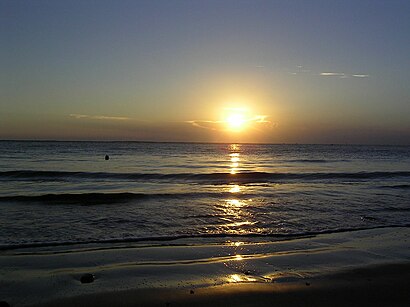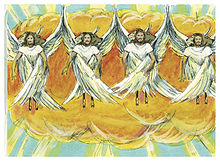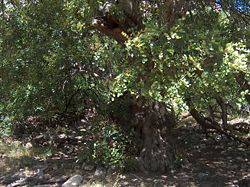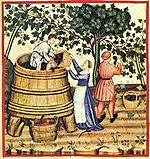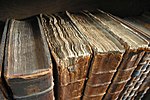Nitzavim
[21] In the sixth reading, Moses said that surely, this Instruction that he enjoined upon them was not too baffling, beyond reach, in the heavens, or beyond the sea; rather it was very close to them, in their mouths and hearts.
[25] But if their hearts turned away and they gave no heed, and were lured into the worship of other gods, Moses warned that they would certainly perish and not long endure in the land.
Similarly, Psalm 50:4–5 reports that God "summoned the heavens above, and the earth, for the trial of His people," saying "Bring in My devotees, who made a covenant with Me over sacrifice!"
The parashah has parallels or is discussed in these early nonrabbinic sources:[33] One of the Dead Sea Scrolls, the Community Rule (1QS), tells how the Qumran sectarians reenacted the covenant renewal ceremony commanded by Deuteronomy 29:10 on an annual basis, many scholars believe on Shavuot.
Another Dead Sea Scroll, The Rule of the Congregation (1QSa), described how the Qumran sectarians planned to reenact that covenant renewal ceremony in the End of Days.
"[38] Similarly, a midrash reported that two teachers offered different explanations of Lamentations 3:12, "He (God) has bent His bow, and set me (וַיַּצִּיבֵנִי, vayatziveni) as a mark for the arrow."
[40] The school of Rabbi Yannai relied on the reference in Deuteronomy 29:9–10 to "the hewer of your wood to the drawer of your water" to teach that slaves, as well, were children of the Covenant.
[46] Similarly, Rabbi Isaac read Deuteronomy 29:14 to teach that the prophets received from the Revelation at Sinai all the messages that they were to prophesy to subsequent generations.
Similarly, Rabbi Isaac concluded that all the Sages who arose in every generation thereafter received their wisdom from the Revelation at Sinai, for Deuteronomy 5:19 says, "These words the Lord spoke to all your assembly .
[47] Reading Deuteronomy 29:14, the Pirke De-Rabbi Eliezer told that at the Revelation at Sinai, when the voice of the first commandment went forth, the heavens and earth quaked, the waters and rivers fled, the mountains and hills moved, all the trees fell prostrate, and the dead who were in Sheol revived and stood on their feet until the end of all the generations.
[49] The Tosefta cited the words of Deuteronomy 29:16, "you have seen their detestable things, and their idols, wood and stone, silver and gold, which were among them," for the proposition that items that were not used for the body of an idol—items that were merely among idols—were permitted to be used.
[51] The heart speaks,[52] sees,[52] hears,[53] walks,[54] falls,[55] stands,[56] rejoices,[57] cries,[58] is comforted,[59] is troubled,[60] becomes hardened,[61] grows faint,[62] grieves,[63] fears,[64] can be broken,[65] becomes proud,[66] rebels,[67] invents,[68] overflows,[69] devises,[70] desires,[71] goes astray,[72] lusts,[73] is refreshed,[74] can be stolen,[75] is humbled,[76] is enticed,[77] errs,[78] trembles,[79] is awakened,[80] loves,[81] hates,[82] envies,[83] is searched,[84] is rent,[85] meditates,[86] is like a fire,[87] is like a stone,[88] turns in repentance,[89] becomes hot,[90] dies,[91] melts,[92] takes in words,[93] is susceptible to fear,[94] gives thanks,[95] covets,[96] becomes hard,[97] makes merry,[98] acts deceitfully,[99] speaks from out of itself,[100] loves bribes,[101] writes words,[102] plans,[103] receives commandments,[104] acts with pride,[105] makes arrangements,[106] and aggrandizes itself.
[107] Rav Judah taught in Rav's name that the words, "that he bless himself in his heart, saying: 'I shall have peace, though I walk in the stubbornness of my heart—that the watered be swept away with the dry'; the Lord will not be willing to pardon him," in Deuteronomy 29:18–19 apply to one who marries his daughter to an old man, or takes a mature wife for his infant son, or returns a lost article to an idolater.
[110] Rabbi Akiva interpreted the words "and [He] cast them into another land, as it is this day" in Deuteronomy 29:27 to teach that the Ten Lost Tribes of Israel were destined not to return.
Rabbi Levi, however, taught that at Yavneh, the strap was untied, and people were no longer subject to punishment for the private sins of individuals.
[113] Rabbi (Judah the Patriarch) taught that when all Israel stood before Mount Sinai to receive the Torah, they decided unanimously to accept the reign of God joyfully.
[118] Rabbi Jose bar Ḥaninah deduced from Deuteronomy 30:5 that when the Jews arrived back in the land of Israel in the time of Ezra, they once again became obligated to obey commandments like tithes (מעשרות, ma'asrot).
The midrash related that a disciple of Rabbi Eliezer ben Jacob used to run through all of his study in a single hour, and when once when he fell ill, he forgot all that he had learned, because he did not speak the words out loud.
"[135] Rabbi Ishmael deduced from the words "choose life" in Deuteronomy 30:19 that one can learn a trade to earn a livelihood, notwithstanding the admonition of Joshua 1:8 that "you shall contemplate [the Torah] day and night.
His wife carried his tefillin to the synagogues and schoolhouses and asked if Deuteronomy 30:20 says, "for that is your life, and the length of your days," why her husband nonetheless died young.
[142] Baḥya also read the words of Deuteronomy 29:28 to provide a reply to the question of why some righteous people do not receive their livelihood except after hard and strenuous toil, while many transgressors are at ease, living a good, pleasant life.
[147] In his Mishneh Torah, Maimonides hinged his discussion of free will on Deuteronomy 30:15, which says, "Behold, I have set before you today life and good, death and evil."
[148] Maimonides taught that people should not entertain the foolish thesis that at the time of their creation, God decrees whether they will be righteous or wicked (what some call "predestination").
Maimonides saw such a view as inconsistent with the entire Torah, with the justice of retribution for the wicked or reward for the righteous, and with the idea that the world's Judge acts justly.
[152] Speaking of duties that benefit or harm only oneself—like fasting, praying, dwelling in a sukkah, taking a lulav, wearing tzitzis, observing the Sabbath and the holidays, refraining from sins—and thus include all duties of the heart, Baḥya ibn Paquda taught that any human action that is either service of God or sin can take place only if three factors occur: (1) the choice in heart and mind, (2) the intent and resolve to do what one chose, and (3) the endeavoring to complete the act with one's physical limbs to bring it into actuality.
The Mishnah Berurah cited this as Scriptural support for the practice of rising early to say prayers for forgiveness (סליחות, Selichot) from the first day of the month of Elul until Yom Kippur.
Alter wrote that the Deuteronomic assumptions about historical causation may seem problematic or even untenable, but the powerful notion of the urgency of moral choice continues to resonate.
Kugel taught that in a sense, all Jewish and Christian devotion—religious services, prayers, the study of Scripture, and dozens of other acts intended to carry out God's will—find at least part of their origin and inspiration in these words.
The prophet rejoiced in God, who had clothed him with salvation, covered him with victory, as a bridegroom dons a priestly diadem, as a bride adorns herself with jewels.
[178] Concluding the series of consolation after Tisha B'Av, and leading up to the Days of Awe, the haftarah features God's salvation,[179] redemption,[180] mercies,[181] and compassion.

